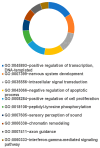Synthetic Lethality between Cohesin and WNT Signaling Pathways in Diverse Cancer Contexts
- PMID: 38607047
- PMCID: PMC11011321
- DOI: 10.3390/cells13070608
Synthetic Lethality between Cohesin and WNT Signaling Pathways in Diverse Cancer Contexts
Abstract
Cohesin is a highly conserved ring-shaped complex involved in topologically embracing chromatids, gene expression regulation, genome compartmentalization, and genome stability maintenance. Genomic analyses have detected mutations in the cohesin complex in a wide array of human tumors. These findings have led to increased interest in cohesin as a potential target in cancer therapy. Synthetic lethality has been suggested as an approach to exploit genetic differences in cancer cells to influence their selective killing. In this study, we show that mutations in ESCO1, NIPBL, PDS5B, RAD21, SMC1A, SMC3, STAG2, and WAPL genes are synthetically lethal with stimulation of WNT signaling obtained following LY2090314 treatment, a GSK3 inhibitor, in several cancer cell lines. Moreover, treatment led to the stabilization of β-catenin and affected the expression of c-MYC, probably due to the occupancy decrease in cohesin at the c-MYC promoter. Finally, LY2090314 caused gene expression dysregulation mainly involving pathways related to transcription regulation, cell proliferation, and chromatin remodeling. For the first time, our work provides the underlying molecular basis for synthetic lethality due to cohesin mutations and suggests that targeting the WNT may be a promising therapeutic approach for tumors carrying mutated cohesin.
Keywords: LY2090314; WNT; c-MYC; cancer; cohesin; synthetic lethality; β-catenin.
Conflict of interest statement
The authors declare no conflicts of interest. The funders had no role in the design of the study; in the collection, analyses, or interpretation of data; in the writing of the manuscript; or in the decision to publish the results.
Figures





Similar articles
-
Cohesin mutations are synthetic lethal with stimulation of WNT signaling.Elife. 2020 Dec 7;9:e61405. doi: 10.7554/eLife.61405. Elife. 2020. PMID: 33284104 Free PMC article.
-
Cohesin Mutations Induce Chromatin Conformation Perturbation of the H19/IGF2 Imprinted Region and Gene Expression Dysregulation in Cornelia de Lange Syndrome Cell Lines.Biomolecules. 2021 Nov 2;11(11):1622. doi: 10.3390/biom11111622. Biomolecules. 2021. PMID: 34827619 Free PMC article.
-
Cohesin gene mutations in tumorigenesis: from discovery to clinical significance.BMB Rep. 2014 Jun;47(6):299-310. doi: 10.5483/bmbrep.2014.47.6.092. BMB Rep. 2014. PMID: 24856830 Free PMC article. Review.
-
Cohesin composition and dosage independently affect early development in zebrafish.Development. 2024 Aug 1;151(15):dev202593. doi: 10.1242/dev.202593. Epub 2024 Aug 1. Development. 2024. PMID: 38975838 Free PMC article.
-
The expanding phenotypes of cohesinopathies: one ring to rule them all!Cell Cycle. 2019 Nov;18(21):2828-2848. doi: 10.1080/15384101.2019.1658476. Epub 2019 Sep 13. Cell Cycle. 2019. PMID: 31516082 Free PMC article. Review.
Cited by
-
Genome Instability and Senescence Are Markers of Cornelia de Lange Syndrome Cells.Cells. 2024 Dec 7;13(23):2025. doi: 10.3390/cells13232025. Cells. 2024. PMID: 39682772 Free PMC article.
References
-
- Koedoot E., van Steijn E., Vermeer M., Gonzalez-Prieto R., Vertegaal A.C.O., Martens J.W.M., Le Devedec S.E., van de Water B. Splicing factors control triple-negative breast cancer cell mitosis through SUN2 interaction and sororin intron retention. J. Exp. Clin. Cancer Res. 2021;40:82. doi: 10.1186/s13046-021-01863-4. - DOI - PMC - PubMed
-
- Balbas-Martinez C., Sagrera A., Carrillo-de-Santa-Pau E., Earl J., Marquez M., Vazquez M., Lapi E., Castro-Giner F., Beltran S., Bayes M., et al. Recurrent inactivation of STAG2 in bladder cancer is not associated with aneuploidy. Nat. Genet. 2013;45:1464–1469. doi: 10.1038/ng.2799. - DOI - PMC - PubMed
Publication types
MeSH terms
Substances
Grants and funding
LinkOut - more resources
Full Text Sources
Medical
Research Materials
Miscellaneous

